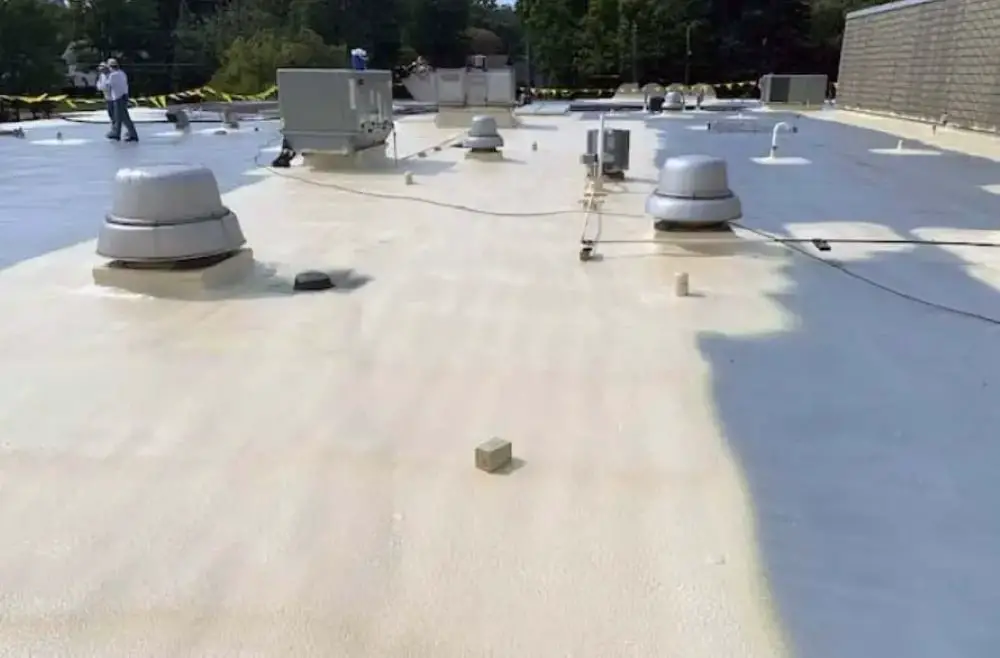Also see: Roof Cost Calculator
Table of Contents

Introduction
I’ve done a lot of research on roof replacement costs for my clients over the years, and I stay current with changes in material and labor pricing across a wide range of roofing systems, including spray polyurethane foam (SPF) roofing. I thought putting together an accurate, regularly updated table of SPF roofing cost estimates would be a good resource for me, my clients, and property managers in general.
The table below shows estimated spray foam application costs (including labor, materials, prep work, and coating) for installing a new SPF roofing system on a commercial low-slope roof.
SPF is one of the most energy-efficient commercial roofing systems available. It can be sprayed onto just about any roof substrate as a liquid mixture that expands into a rigid foam, forming a fully adhered, monolithic surface. The foam is then primed and coated with a protective elastomeric coating, usually silicone, to shield it from UV radiation and weathering. The result is a seamless, self-flashing roof system that provides both waterproofing and insulation in a single application.
Properly-coated spray foam roofing offers several advantages: very high R-value per inch of thickness, resistance to ponding water, reduced air infiltration, minimal maintenance needs, and the ability to conform to irregular surfaces. It is particularly well suited to retrofit applications on older low-slope roofs that may be difficult to re-cover using conventional materials.
The overall cost of an SPF roof depends on the thickness of the foam, the amount and type of prep work needed, and the coating system used. Light prep typically involves surface cleaning and minor patching, while heavy prep may include deck repairs or removal of wet areas in the existing roof, if not the whole thing. Material and labor costs also vary by region, roof size, and site accessibility.
As of 2025, the average application cost for an SPF roof ranges from around $7.00 per square foot for a 2-inch foam system with light prep to over $13.00 per square foot for thicker systems with more intensive prep work. A silicone coating alone, such as for a maintenance recoat, typically costs around $2.25 per square foot.
For a typical commercial roof measuring 25,000 square feet, total application costs range from approximately $175,000 on the low end to over $330,000 for high-end systems with 5 inches of foam and full surface remediation.
Also see my Roof Replacement Cost Guide, which has typical current roof prices for other residential and commercial roofing materials.
About Spray Polyurethane Foam Roofing
Spray polyurethane foam (also called “SPF” or just “spray foam”) is a type of roofing system created by spraying a two-part liquid mixture (an isocyanate and a polyol resin) directly onto the roof. The chemicals react and expand on contact, forming a continuous layer of rigid foam that sticks to the surface and hardens in place. All spray foam roofing is closed-cell SPF. This foam is then protected with a durable coating (silicone is typically recommended by manufacturers), which shields it from UV rays, weather, and foot traffic, to some extent.
SPF roofing is often used to restore older roofs, especially when the surface is irregular or prone to ponding water. Because it conforms to just about any shape, SPF can be used to fill in low spots and improve drainage while adding insulation. It’s also used in new construction, particularly on commercial or industrial buildings where energy efficiency and leak prevention are priorities.
The installation process involves surface preparation, which may include extensive cleaning and priming. The foam is then sprayed directly onto the roof deck or over an existing roof surface. Multiple passes are used to achieve the desired thickness, the surface of the foam may then be primed, depending on the coating, and the protective coating, applied as a base coat and then a top coat, completes the system. SPF systems can be recoated periodically to extend service life, which often exceeds 20 years with proper maintenance.
Limitations include sensitivity to installation conditions, such as temperature and humidity, and the need for highly-skilled applicators. Overspray during application can be a concern, especially in windy conditions, requiring protective measures for surrounding areas.
Spray Foam R-Value
SPF provides one of the highest R-values per inch among commercially available insulation materials, ranging approximately from R-5 to R-7.5 per inch of thickness depending on the formulation and density of the foam.
Several factors make this high R-value significant:
- Enhanced Energy Efficiency: A higher R-value means better insulation, which directly contributes to reduced energy consumption for heating and cooling. Buildings with SPF roofing systems often experience lower utility costs due to minimized heat gain or loss.
- Moisture and Air Barrier: SPF acts not only as insulation but also as an air barrier, effectively reducing air leakage that can lead to significant energy losses. This dual role enhances the overall thermal performance beyond R-value alone.
- Continuous Insulation Layer: Because SPF is sprayed in place, it forms a monolithic layer without seams or joints. This eliminates thermal bridging, a common issue in systems with mechanically fastened insulation boards. The uniform coverage ensures consistent R-value across the entire roof surface.
- Performance in Retrofit Applications: In re-roofing scenarios, SPF can be applied over existing systems without removing the old roof, and it can be used to correct substrate irregularities while providing uniform insulation. Its high R-value in thinner profiles is useful in situations where roof height or parapet wall constraints may limit insulation thickness.
- Long-Term Value Retention: Closed-cell SPF maintains its R-value over time due to its low permeability and stable structure. When properly protected with a coating, the material resists moisture intrusion and retains its insulating properties for decades.
Roof Preparation
Preparing an existing roof for a spray polyurethane foam application involves a sequence of steps that ensure strong adhesion, system integrity, and long-term performance. The process may vary slightly depending on the roof type and condition, but generally includes the following:
Assessment and Inspection:
The existing roof is first evaluated to determine any issues that may interfere with the SPF application. Any areas with water damage, saturated insulation, or otherwise compromised substrates must be identified. This step ensures that the existing roof is an appropriate substrate for the SPF system or whether removal or partial removal is necessary.
Typical cost: $0.10 to $0.25 per square foot (depending on whether infrared scanning, core cuts, or moisture probes are involved).
Removal of Unfit Materials:
If the existing roof is in poor condition, has multiple layers of roofing, wet insulation, or deteriorated membranes, those materials must be removed. Roofs with trapped moisture are particularly problematic, as this can compromise foam adhesion and create long-term issues.
Typical cost: $1.00 to $3.50 per square foot (cost varies based on number of roof layers, disposal fees, and how hard it is to remove the material).
Repairs:
If only part of the roof is damaged or wet, those sections are removed and replaced with compatible materials. The substrate must be dry before foam is applied, as moisture inhibits the chemical reaction needed for foam expansion and curing.
Typical cost: $0.75 to $2.50 per square foot (includes localized tear-off, patching, and substrate repair or replacement).
Cleaning:
A clean surface is necessary for proper foam adhesion. The roof is typically pressure-washed or vacuumed to remove dust, dirt, oils, debris, and vegetation. Some substrates may require more aggressive methods such as abrasive blasting or, in the case of an existing SPF roof, scarification.
Typical cost: $0.15 to $0.60 per square foot (varies by cleaning method and contamination level).
Priming (if required):
Depending on the substrate type (e.g., metal, concrete, existing roof membrane), a primer may be needed to improve adhesion. Primer selection is based on the substrate’s chemistry and surface profile.
Typical cost: $0.25 to $0.75 per square foot (includes labor and material cost of primer).
Detailing Penetrations and Edges:
All roof penetrations, flashings, and edge details must be sealed and prepared to receive foam. This step includes taping seams, sealing joints, or applying base coats around transitions to create a continuous and sealed surface.
Typical cost: $0.50 to $1.50 per square foot (applied only to detail areas, not full field).
Masking and Protection:
Areas not to receive the SPF, such as HVAC units, skylights, and vertical walls, are masked off to protect against overspray. This is important since foam particles can be carried by the wind during application.
Typical cost: $0.10 to $0.30 per square foot (average over total roof area, depending on number of protected elements).
Once these preparations are complete, the SPF is sprayed in successive passes to achieve the required thickness, followed by the application of a protective coating. This method allows SPF systems to be installed as retrofits over many types of existing roofing.
Importance of Coating a Spray Foam Roof
A protective surface coating is necessary for a spray polyurethane foam roof due to the foam’s inherent vulnerability to ultraviolet (UV) radiation and physical wear. Without a coating, exposure to sunlight can degrade the foam’s surface within days, leading to loss of structural integrity and water resistance. Environmental elements such as wind-driven debris, hail, and temperature fluctuations can also physically damage unprotected SPF, compromising its performance and lifespan.
The coating serves multiple critical purposes:
- UV Protection: SPF deteriorates rapidly under UV exposure, becoming brittle and powdery. A coating blocks UV rays, preserving the foam’s elasticity and structural cohesion.
- Waterproofing: While the SPF used for roofing is closed-cell and inherently water-resistant, a coating adds a durable waterproof membrane that prevents water infiltration through surface imperfections or minor cracks.
- Impact Resistance: Coatings can improve the system’s resilience against mechanical damage from foot traffic, hail, or debris.
- Maintenance and Longevity: Coatings can be reapplied periodically to extend the roof’s service life significantly, often allowing systems to perform for decades. Periodic recoating every 10 to 20 years is recommended to maintain long-term waterproofing and insulation performance.
Coatings Used on Spray Foam Roofs
Silicone Coatings:
Widely regarded as the top choice for SPF roofs, silicone coatings are highly resistant to UV radiation, ponding water, and extreme temperatures. They maintain flexibility over time and are particularly suitable for climates with heavy rainfall.
Typical installed cost: $2.00 to $3.50 per square foot (material plus labor).
Acrylic Coatings:
These water-based coatings are cheaper and offer UV resistance. They are best suited for dry climates because they are far less resistant to ponding water compared to silicone. Acrylics are easy to apply and maintain but may require more frequent recoating. Acrylic coatings should never be applied over an existing silicone coating.
Typical installed cost: $1.25 to $2.25 per square foot.
Polyurethane Coatings:
Known for their exceptional impact and abrasion resistance, polyurethane coatings are useful in high-traffic areas or where mechanical durability is a priority. They are typically used in conjunction with other coatings to balance toughness with UV protection.
Typical installed cost: $2.50 to $4.00 per square foot when used as part of a two-coat system.
Things to Keep in Mind
These SPF roofing cost estimates should be reasonably accurate. I make an effort to keep them up to date using current material pricing and labor data from across the industry.
Keep in mind that the costs listed below are national averages, and actual prices can vary depending on your region, local labor rates, and project complexity. For a more accurate estimate of SPF roof costs in your area, see “Relative Construction Costs by U.S. State” and apply your local multiplier to the national average.
The SPF roofing costs shown here assume application on commercial low-slope roofs.
The tables also assume the use of closed-cell spray polyurethane foam at an average density of 2.8 to 3.0 lb/ft³, applied in lifts to the specified thickness, followed by a silicone coating with embedded granules where appropriate. Light prep typically includes cleaning, minor patching, and priming where required. Heavy prep involves removal of wet areas, structural deck repairs, and more intensive surface remediation. Additional factors like excessive mechanical units, poor roof access, or highly irregular surfaces may increase costs.
Table: Spray Foam Roofing Cost per Square Foot
| Average Cost of a Spray Polyurethane Foam Roof | |||
|---|---|---|---|
| SPF Application Type | Average Application Cost Per Square Foot |
Average Application Cost Per Square (100 sq. ft.) |
Average Application Cost Typical Commercial Roof (25,000 sq. ft.) |
| SPF Alone Per Inch | $1.50 | $150 | $37,500 |
| Silicone Coating Alone | $2.25 | $225 | $56,250 |
| SPF 2 Inch Thick Silicone Coating Light Prep |
$7.00 | $700 | $175,000 |
| SPF 2 Inch Thick Silicone Coating Heavy Prep |
$8.75 | $875 | $218,750 |
| SPF 3 Inch Thick Silicone Coating Light Prep |
$8.50 | $850 | $212,500 |
| SPF 3 Inch Thick Silicone Coating Heavy Prep |
$10.25 | $1,025 | $256,250 |
| SPF 4 Inch Thick Silicone Coating Light Prep |
$10.00 | $1,000 | $250,000 |
| SPF 4 Inch Thick Silicone Coating Heavy Prep |
$11.75 | $1,175 | $293,750 |
| SPF 5 Inch Thick Silicone Coating Light Prep |
$11.50 | $1,150 | $287,500 |
| SPF 5 Inch Thick Silicone Coating Heavy Prep |
$13.25 | $1,325 | $331,250 |

